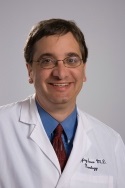Science and Policy Create Opportunity
 After decades of progress during which stroke dropped from the No. 3 killer of Americans to No. 5, death rates have begun to inch back up, in part because of high rates of obesity and high blood pressure. American Heart Association/American Stroke Association (AHA/ASA) volunteer Jeffrey Saver, M.D., believes that science alone won’t be able to reverse this disheartening trend.
After decades of progress during which stroke dropped from the No. 3 killer of Americans to No. 5, death rates have begun to inch back up, in part because of high rates of obesity and high blood pressure. American Heart Association/American Stroke Association (AHA/ASA) volunteer Jeffrey Saver, M.D., believes that science alone won’t be able to reverse this disheartening trend.
“As a physician, I can help my patients in the tens or hundreds, but through science, outreach and advocacy we can affect millions of people,” says Dr. Saver, who has served as director for the University of California, Los Angeles (UCLA) Stroke Unit since its inception in 1995.
Researchers in Western States Affiliate are making progress. He points toward two recent advances in stroke diagnosis and treatment as examples. A study led by researchers at UCLA, showed that using a device to remove large blood clots, in addition to administering the clot-busting drug tPA, significantly reduces disability in people suffering an acute ischemic stroke.
And a trial led by researchers at Stanford University in Northern California used advanced MRI (magnetic resonance imaging) and CT (computerized tomography) scans to identify late-presenting patients whose strokes progress at a slower pace. The additional time affords these patients the opportunity for late interventions, sometimes six to 24 hours after the stroke’s onset, with much-improved recovery. The combination of the extra time and additional treatment is a win-win for stroke patients.
Alongside advances like these, influencing people toward healthier behaviors will be instrumental in reversing stroke rates. “We have a great opportunity here in the West to interact with diverse populations in effecting healthy change and tailored cultural stroke education,” Dr. Saver says.
Target: BP(link opens in new window) and Check.Change.Control(link opens in new window) are two programs that address high blood pressure, which is on the rise in Latino communities and is a precursor to stroke. Both programs include outreach to underserved communities to bring attention to the issue, offer education and support treatment options.
In addition, strong public policy results in healthier communities. The AHA/ASA’s You’re the Cure(link opens in new window) advocacy network makes a difference by supporting measures that help build healthier communities and healthier lives.
Dr. Saver recently received the AHA/ASA Gold Heart award, its highest volunteer honor for decades of service to the association and contributions to stroke care. His efforts include championing the use of tPA. Now widely used, tPA has been transformational in preventing disability from stroke.





